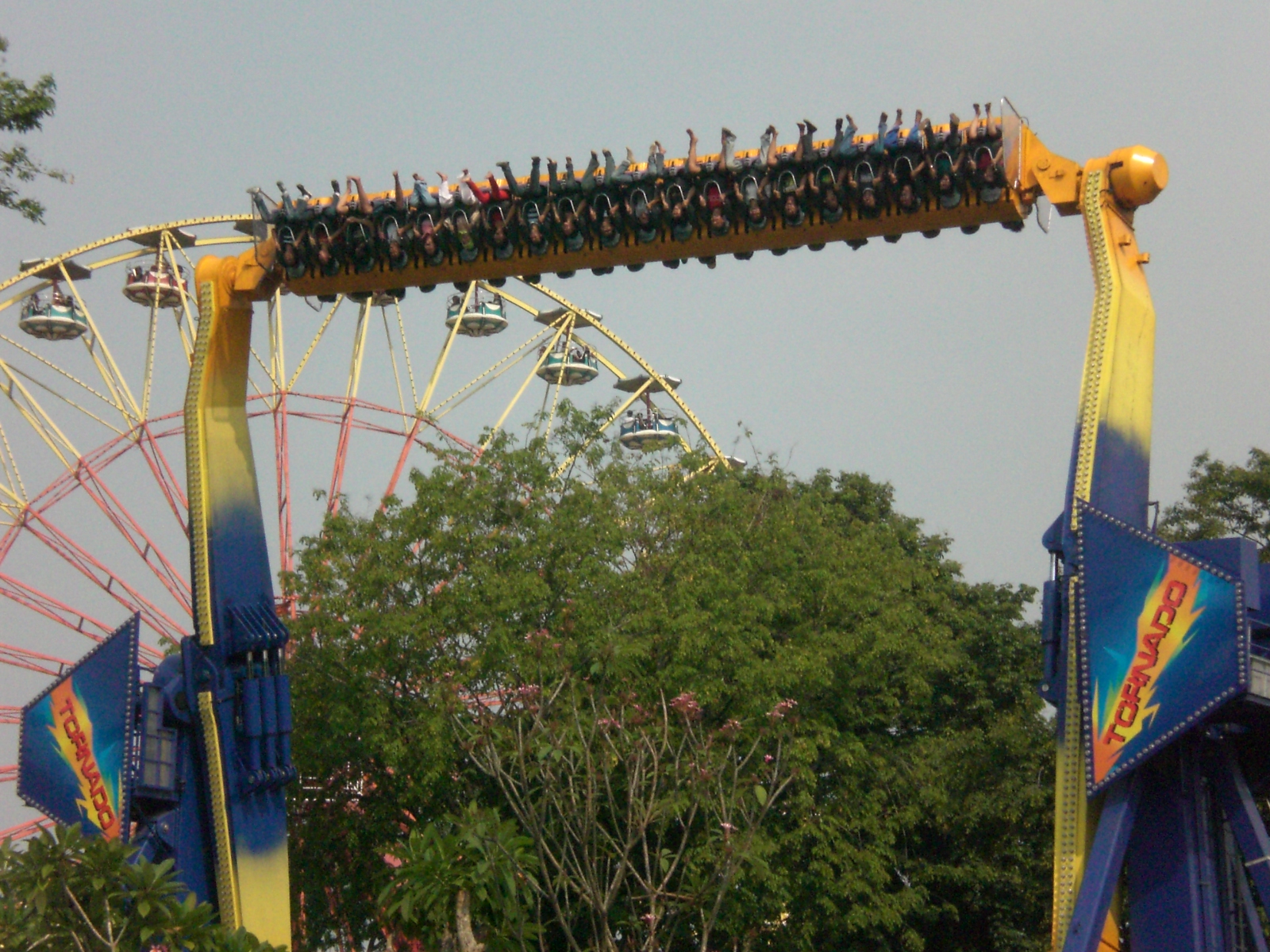|
Happy Valley Shanghai
Happy Valley Shanghai () is an amusement park in Shanghai, China. The park is located in Songjiang District, approximately from downtown Shanghai. It covers an area of . Opened on 16 August 2009, it is the fourth installation of the Happy Valley theme park chain. Notable rides Happy Valley Shanghai contains seven major areas, each with different themed zones, including Sunshine Beach, Happy Times, Typhoon Bay, Gold Mine Town, Ant Kingdom, Shanghai Beach and Shangri-la Woods. There are more than 100 attractions in the park. Notable rides include: File:Mega-Lite_-_Happy_Valley_Shanghai_2.jpg File:Fireball_-_Happy_Valley_Shanghai_5.jpg File:Happy Valley Shanghai 04.jpg File:Happy Valley Shanghai 06.jpg File:Happy Valley Shanghai 05.jpg File:First_Pathway_Happy_Valley_Shanghai_Night.jpg References {{Theme parks in Shanghai 2009 establishments in China Amusement parks in Shanghai Amusement parks opened in 2009 Shanghai Shanghai (; , , Standard Mandarin pronu ... [...More Info...] [...Related Items...] OR: [Wikipedia] [Google] [Baidu] |
Martin & Vleminckx
Martin & Vleminckx is a roller coaster manufacturing and construction company headquartered in Montreal, Quebec, Canada with an affiliated office and manufacturing facility in Haines City, Florida, United States, and two subsidiaries, including a warehouse, in China. History Martin & Vleminckx was founded in 1984 by Ghislain Martin and Alain Vleminckx. The company has since expanded to feature a team of 50 staff. Martin & Vleminckx supplied the first wooden roller coaster to China in 2009. Martin & Vleminckx worked alongside government officials to develop regulations for Chinese wooden roller coasters, before '' Wooden Coaster - Fireball'' at Happy Valley Shanghai could be approved to open. In the past decade, Martin & Vleminckx has become the primary wooden roller coaster supplier in China. Projects Martin & Vleminckx has erected roller coasters and other amusement rides manufactured by a variety of companies from around the world. Including: Bolliger & Mabillard, Chance Morgan ... [...More Info...] [...Related Items...] OR: [Wikipedia] [Google] [Baidu] |
Shanghai
Shanghai (; , , Standard Mandarin pronunciation: ) is one of the four direct-administered municipalities of the People's Republic of China (PRC). The city is located on the southern estuary of the Yangtze River, with the Huangpu River flowing through it. With a population of 24.89 million as of 2021, Shanghai is the most populous urban area in China with 39,300,000 inhabitants living in the Shanghai metropolitan area, the second most populous city proper in the world (after Chongqing) and the only city in East Asia with a GDP greater than its corresponding capital. Shanghai ranks second among the administrative divisions of Mainland China in human development index (after Beijing). As of 2018, the Greater Shanghai metropolitan area was estimated to produce a gross metropolitan product (nominal) of nearly 9.1 trillion RMB ($1.33 trillion), exceeding that of Mexico with GDP of $1.22 trillion, the 15th largest in the world. Shanghai is one of the world's major centers for ... [...More Info...] [...Related Items...] OR: [Wikipedia] [Google] [Baidu] |
Amusement Parks In Shanghai
Amusement is the state of experiencing humorous and entertaining events or situations while the person or animal actively maintains the experience, and is associated with enjoyment, happiness, laughter and pleasure. It is an emotion with positive valence and high physiological arousal. Amusement is considered an "epistemological" emotion because humor occurs when one experiences a cognitive shift from one knowledge structure about a target to another, such as hearing the punchline of a joke. The pleasant surprise that happens from learning this new information leads to a state of amusement which people often express through smiling, laughter or chuckling. Current studies have not yet reached consensus on the exact purpose of amusement, though theories have been advanced in the fields of psychology, psychiatry, and sociology. In addition, the precise mechanism that causes a given element (image, sound, behavior, etc.) to be perceived as more or less 'amusing' than another simil ... [...More Info...] [...Related Items...] OR: [Wikipedia] [Google] [Baidu] |
2009 Establishments In China
9 (nine) is the natural number following and preceding . Evolution of the Arabic digit In the beginning, various Indians wrote a digit 9 similar in shape to the modern closing question mark without the bottom dot. The Kshatrapa, Andhra and Gupta started curving the bottom vertical line coming up with a -look-alike. The Nagari continued the bottom stroke to make a circle and enclose the 3-look-alike, in much the same way that the sign @ encircles a lowercase ''a''. As time went on, the enclosing circle became bigger and its line continued beyond the circle downwards, as the 3-look-alike became smaller. Soon, all that was left of the 3-look-alike was a squiggle. The Arabs simply connected that squiggle to the downward stroke at the middle and subsequent European change was purely cosmetic. While the shape of the glyph for the digit 9 has an ascender in most modern typefaces, in typefaces with text figures the character usually has a descender, as, for example, in . The mod ... [...More Info...] [...Related Items...] OR: [Wikipedia] [Google] [Baidu] |
Inverted Coaster
An inverted roller coaster is a roller coaster in which the train runs under the track with the seats directly attached to the wheel carriage. This latter attribute is what sets it apart from the older suspended coaster, which runs under the track, but ''swings'' via a pivoting bar attached to the wheel carriage. The coaster type's inverted orientation, where the passengers' legs are exposed, distinguishes it from a traditional roller coaster, where only the passengers' upper body parts, including the arms, are exposed. The inverted coaster was pioneered by the Swiss roller coaster designers Bolliger & Mabillard in the early 1990s. The first installation came at Six Flags Great America in 1992. Other roller coaster manufacturers followed in the footsteps of Bolliger & Mabillard and began working on their own inverted coaster designs, including Vekoma, Intamin and other smaller companies. Intamin has few designs classified as inverted coasters, although they do install inverted ... [...More Info...] [...Related Items...] OR: [Wikipedia] [Google] [Baidu] |
Inverted Roller Coaster
An inverted roller coaster is a roller coaster in which the train runs under the track with the seats directly attached to the wheel carriage. This latter attribute is what sets it apart from the older suspended coaster, which runs under the track, but ''swings'' via a pivoting bar attached to the wheel carriage. The coaster type's inverted orientation, where the passengers' legs are exposed, distinguishes it from a traditional roller coaster, where only the passengers' upper body parts, including the arms, are exposed. The inverted coaster was pioneered by the Swiss roller coaster designers Bolliger & Mabillard in the early 1990s. The first installation came at Six Flags Great America in 1992. Other roller coaster manufacturers followed in the footsteps of Bolliger & Mabillard and began working on their own inverted coaster designs, including Vekoma, Intamin and other smaller companies. Intamin has few designs classified as inverted coasters, although they do install inverted ... [...More Info...] [...Related Items...] OR: [Wikipedia] [Google] [Baidu] |
Family Inverted Coaster (Happy Valley Shanghai)
Family Inverted Coaster is a steel roller coaster at Happy Valley Shanghai in China. It is the first Family Inverted Coaster manufactured by Bolliger & Mabillard Bolliger & Mabillard, officially Bolliger & Mabillard Consulting Engineers, Inc. and often abbreviated B&M, is a roller coaster design consultancy based in Monthey, Switzerland. The company was founded in 1988 by Walter Bolliger and Claude Mabil .... Roller coasters in China {{amusement-ride-stub ... [...More Info...] [...Related Items...] OR: [Wikipedia] [Google] [Baidu] |
Wooden Roller Coaster
A wooden roller coaster is a type of roller coaster classified by its wooden track, which consists of running rails made of flat steel strips mounted on laminated wood. The support structure is also typically made of wood, but may also be made of steel lattice or truss, which has no bearing on a wooden coaster's classification. The type of wood often selected in the construction of wooden coasters worldwide is southern yellow pine, which grows abundantly in the southern United States, due to its density and adherence to different forms of pressure treatment. Early wooden roller coaster design of the 19th century featured a single set of wheels running on top of the track, which was common in scenic railway rides. John A. Miller introduced side friction coasters and later underfriction coasters in the early 20th century, which added additional sets of wheels running along multiple sides of the track to allow for more intense ride design with sharper turns and steeper d ... [...More Info...] [...Related Items...] OR: [Wikipedia] [Google] [Baidu] |
Wooden Coaster - Fireball
Wooden Coaster - Fireball () is a wooden roller coaster located at Happy Valley in Songjiang, Shanghai, China. The coaster was designed by American wooden coaster designers The Gravity Group and manufactured by Martin & Vleminckx Martin & Vleminckx is a roller coaster manufacturing and construction company headquartered in Montreal, Quebec, Canada with an affiliated office and manufacturing facility in Haines City, Florida, United States, and two subsidiaries, including a .... It opened on August 16, 2009 as China's first wooden roller coaster. Awards References Wooden roller coasters {{Happy Valley (amusement parks) Roller coasters in China ... [...More Info...] [...Related Items...] OR: [Wikipedia] [Google] [Baidu] |
Zamperla
Antonio Zamperla S.p.A. is an Italian design and manufacturing company founded in 1966. It is best known for creating family rides, thrill rides and roller coasters worldwide. The company also makes smaller coin-operated rides commonly found inside shopping malls. Zamperla builds roller coasters, like the powered Dragon Coaster, Mini Mouse, Zig Zag, and Volare. In 2006, Zamperla announced Motocoaster, a motorcycle-themed roller coaster. Rights to some of S.D.C.'s rides were handed to Zamperla (along with S&C and S&MC) after the company went bankrupt in 1993. In 2005 the founder of the company, Mr. Antonio Zamperla, became the first Italian to be inducted into the IAAPA Hall of Fame by virtue of his significant contribution to the entire industry, joining other pioneers such as Walt Disney, George Ferris and Walter Knott. Unlike companies such as Intamin, Vekoma, or Bolliger & Mabillard that concentrate on larger and faster roller coasters, Zamperla focuses on more family-f ... [...More Info...] [...Related Items...] OR: [Wikipedia] [Google] [Baidu] |
Wild Mouse Roller Coaster
A wild mouse is a type of roller coaster consisting of single or spinning cars traversing a tight-winding track with an emphasis on sharp, unbanked turns. The upper portion of the track usually features multiple 180-degree turns, known as flat turns, that produce high lateral G-force The gravitational force equivalent, or, more commonly, g-force, is a measurement of the type of force per unit mass – typically acceleration – that causes a perception of weight, with a g-force of 1 g (not gram in mass measure ...s even at modest speeds. Cars are often designed to be wider than the track to enhance the illusion of hanging over the edge. Lower portions of the track typically feature small hills and bunny hops. Wild mouse coasters first appeared in the 1950s, and following a period of decline in the 1980s, new innovations and layout designs in the late 1990s led to a resurgence in demand. History During the 1950s, wild mouse roller coasters began to appear at a ... [...More Info...] [...Related Items...] OR: [Wikipedia] [Google] [Baidu] |



